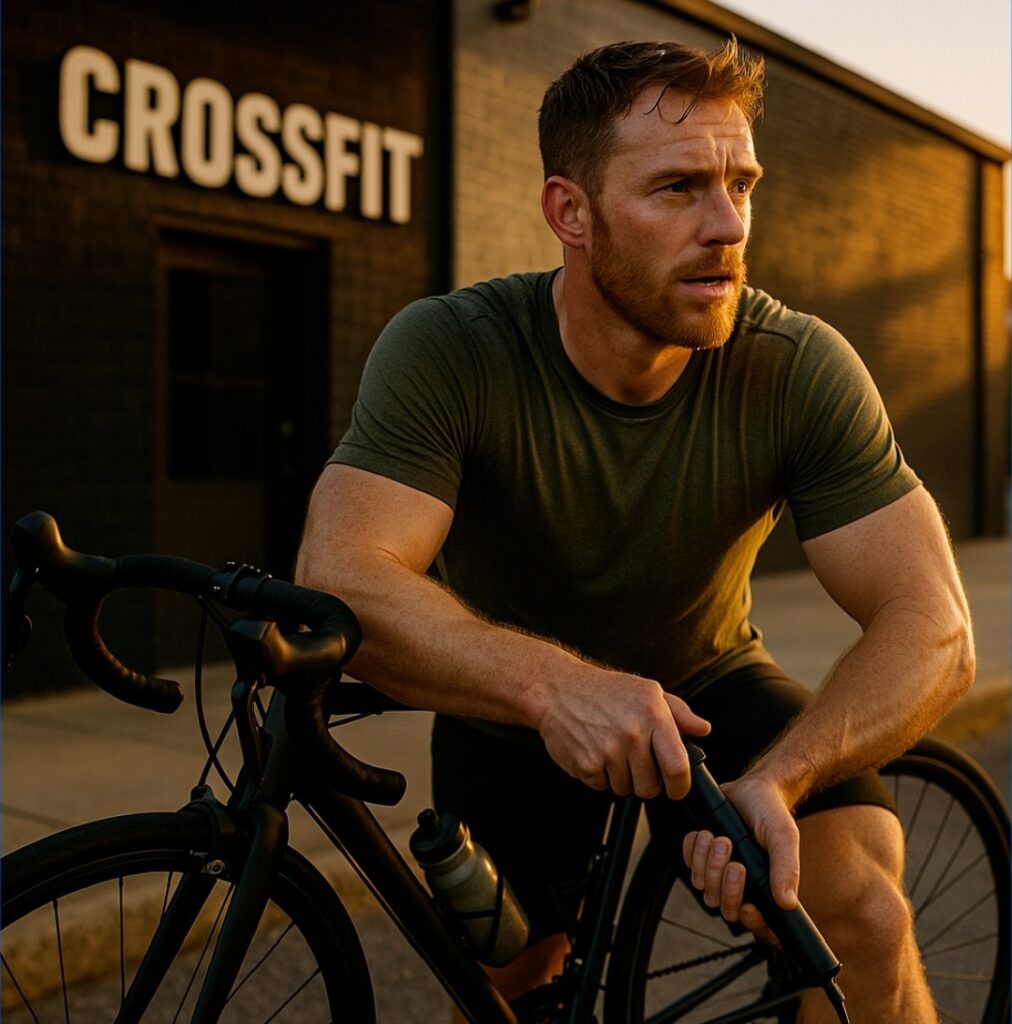The air still smells like iron and effort. The gym’s music fades, replaced by the quiet hum of an early morning. I toss my towel over one shoulder and step into the cool air outside the CrossFit box. My bike leans against the curb — matte black, a little scuffed, but it’s seen more miles than most cars parked nearby. Some athletes drive home in pickups; I ride. It’s not about saving gas — it’s about carrying that gym energy into motion.
From the Box to the Road: What CrossFit Builds
CrossFit doesn’t just make you stronger — it rewires the way you move. Years of compound lifts and WODs teach your body to coordinate power from head to toe. Strong quads, a stable core, a back that doesn’t fold halfway through a climb — these aren’t luxuries for cyclists, they’re advantages. Every heavy clean and jerk translates into smoother pedaling, every deadlift builds the endurance to stay upright through long climbs.
CrossFit also hardens your tolerance to fatigue. After a dozen sessions of thrusters, burpees, and rowing intervals, a long ride feels like a meditative challenge instead of torture. I’ve ridden with guys who crumble after twenty kilometers — not from weak legs, but from a restless mind. CrossFit teaches you how to stay calm under pressure, to control your breathing when it burns, to keep rhythm when everything says stop.
Balance and coordination? They come straight from the box floor. If you’ve ever done overhead squats or kettlebell snatches, you already know what micro‑stabilization means. On a bike, that translates to cleaner turns, smoother descents, and fewer mistakes when fatigue sets in.
And yet, all this power can be wasted if your tires aren’t ready. A reliable bike pump may seem like a small thing, but it’s the unsung hero of every ride. I’ve lost count of how many times a simple pressure check saved a training session. Whether you’re topping up before a Sunday ride or fixing a soft tire after a brutal leg day, that little tool is what keeps the momentum going.
Why Cycling Complements CrossFit
Cycling fits into a CrossFitter’s life better than most realize. It’s the perfect form of active recovery — movement without impact. It keeps the legs turning, blood flowing, and joints safe. I started riding on rest days just to “flush the legs,” but soon realized how restorative it was. The soreness fades faster, sleep improves, and mentally, it’s like hitting reset.
After the chaos of the gym — barbells slamming, timers beeping, music blasting — the road feels like therapy. The air is steady, and the rhythm of pedaling smooths your thoughts. You shift from intensity to endurance, from fight mode to flow state. That switch, from explosive to steady, does more for performance than most supplements ever could.
It’s no coincidence that top CrossFit athletes — from Tia‑Clair Toomey to Rich Froning — include cycling or assault‑bike sessions in their endurance blocks. It teaches pacing, lung capacity, and patience — three things you can’t fake under heavy load.
Gear That Keeps You Moving
Outside the gym, performance is dictated by preparation. A proper saddle saves your hips; a good helmet protects what matters most. Shoes, grips, and even your seat height can decide whether you finish your ride fresh or fried.
A solid bike pump might sound trivial, but when you combine CrossFit intensity with outdoor rides, you quickly learn that small details decide whether you move or stop. Mini pumps live in my backpack — they’ve saved me more than once mid‑ride. Floor pumps? That’s my go‑to before any weekend-long ride, giving me precise pressure and stability. And yes, I tested an electric one too — perfect for when I’m multitasking recovery work with gear prep.
The right tools keep you consistent. They don’t add effort — they remove friction.
Lessons Both Worlds Share
CrossFit and cycling might seem like opposites — one’s about explosive chaos, the other about steady rhythm — but they share the same foundation: discipline. Both teach respect for recovery, patience with progress, and awareness of your limits.
CrossFit builds fire and grit. Cycling teaches humility and flow. Together, they show you how to manage energy — when to sprint, when to hold pace, when to breathe instead of break. The best athletes I’ve met aren’t the strongest or fastest; they’re the ones who know when to push and when to recover.
My Personal Routine
After a week of heavy lifts, I grab my bike for a 60‑minute hill ride. Nothing fancy — no heart‑rate monitor, no playlist. Just me, the climb, and my thoughts. At first, it was “active recovery.” Then it became something else — a way to think, to decompress, to reconnect with movement outside metrics. That hour on the road clears the mental clutter. My breathing syncs, my focus resets, and by the time I get home, I feel sharper — physically and mentally.
Sometimes I’ll stop halfway, deflate the tires a bit for grip, then use my pump to top them off before the descent. It’s a small ritual now — like setting intention before the ride down.
Reflection
Whether it’s barbells or pedals, your body speaks one language: movement. Strength without endurance is loud but short‑lived; endurance without strength is quiet but incomplete. The magic happens where they meet — the balance between fire and flow.
So pump the tires, steady your breath, and ride. Strength means nothing if it doesn’t move you forward. And yes, keep that bike pump close — because in both fitness and life, it’s the little habits that keep you rolling.



